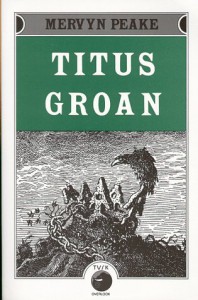 I've been (re-)reading Mervyn Peake, [a:Jack Vance|5376|Jack Vance|http://d.gr-assets.com/authors/1207604643p2/5376.jpg], and [a:Robert Silverberg|4338|Robert Silverberg|http://d.gr-assets.com/authors/1366300348p2/4338.jpg], all at the same time. I was surprised by the similarity between Vance and Silverberg, but more on that (and Silverberg and Peake, for that matter) in my eventual review of [b:Lord Valentine's Castle|252838|Lord Valentine's Castle (Majipoor, #1)|Robert Silverberg|http://d.gr-assets.com/books/1173157310s/252838.jpg|245141]. I expected some similarity between Vance and Peake, who both leave the impression of dense, intricate language to which the plot is subsidiary. That's true, but there are substantial differences. With Vance, it's all about the language itself, the way he uses words - you're left with a sense that the text itself was beautifully, artfully arranged. With Peake, it's more about the images - striking descriptions that stay with you for a very long time - for example, of one of the Mud Dwellers standing "in a pool of his own midnight".
I've been (re-)reading Mervyn Peake, [a:Jack Vance|5376|Jack Vance|http://d.gr-assets.com/authors/1207604643p2/5376.jpg], and [a:Robert Silverberg|4338|Robert Silverberg|http://d.gr-assets.com/authors/1366300348p2/4338.jpg], all at the same time. I was surprised by the similarity between Vance and Silverberg, but more on that (and Silverberg and Peake, for that matter) in my eventual review of [b:Lord Valentine's Castle|252838|Lord Valentine's Castle (Majipoor, #1)|Robert Silverberg|http://d.gr-assets.com/books/1173157310s/252838.jpg|245141]. I expected some similarity between Vance and Peake, who both leave the impression of dense, intricate language to which the plot is subsidiary. That's true, but there are substantial differences. With Vance, it's all about the language itself, the way he uses words - you're left with a sense that the text itself was beautifully, artfully arranged. With Peake, it's more about the images - striking descriptions that stay with you for a very long time - for example, of one of the Mud Dwellers standing "in a pool of his own midnight".I can't remember when I first encountered Peake, or how. Sometime after reading the [b:The Castle of Otranto|12923|The Castle of Otranto|Horace Walpole|http://d.gr-assets.com/books/1166512753s/12923.jpg|46432], with its memorable giant helmet, but probably quite a few years later. In any case, I was immediately taken with Titus Groan, or, more properly, with Gormenghast, because while the first book of the trilogy is named after Titus, and the second after the castle, the focus is the other way around. Briefly, Titus Groan deals with the birth of violet-eyed Titus, the 77th Earl of Groan. The Groans inhabit Gormenghast Castle, near Gormenghast Lake, by Gormenghast Mountain. It's a setting and a family entirely and strictly bound by tradition and rules, all carefully written down, and governing everything from breakfast to the order of the day. The rituals are rigidly enforced, and absolutely meaningless. After hundreds of years of stangation, two wild cards enter the scene - Titus the baby, and Steerpike, a kitchen boy carefully, slyly, jumping himself up from one status to another.
At first, though, it's the setting itself that captures your attention. Peake starts in Gormenghast's Hall of Bright Carvings, a neglected chamber on an upper level of the castle. It's an image that has stayed with me since I first read the book (and one that the good BBC series gets sadly wrong). Floor thick with dust, caretaker sleeping in a hammock at the end, single window shuttered, the hall collects the painted wooden figures that are the culmination of the lives of the Bright Carvers, one of the few intersections between castle dwellers and those outside. We soon leave the Hall, but as we follow Steerpike on his early escapades, we get a sense of just how vast the castle is. Peake isn't terribly clear on the layout (though there are north, south, east, and west wings), but the point is really that the castle is vast, and essentially flows from horizon to horizon in complex waves of rooftops, walls, and towers. The ruinous Tower of Flints stands above it all, inhabited only by owls. The place is so large, with so many secrets, that there are literally lakes and plains, birds and horses, all within or upon the castle. There's some of everything in the castle, and it's all in disrepair.
Titus disrupts this unintentionally, providing a focus for the human stories of the queer characters that inhabit the story - his teen sister Fuchsia, Nanny Slag, Keda the wetnurse, Doctor Prunesquallor and his sister Irma, Steerpike, the Earl and his wife, the Earl's two sisters, the servants Flay and Swelter, and a few others. They're all memorable, exaggerated creatures. Steerpike is a Machiavellian schemer and rebel. Flay is taciturn but devoted to his troubled master the Earl. Swelter is a massive, clever presence ruling the kitchens. While the focus is on Steerpike, a substantial, tense sub-plot is devoted to a feud between Flay and Swelter.
The few notes of relative reality are provide by Fuchsia, a scatterbrained, dreaming girl, and Keda, Titus' wetnurse. Keda, the widow of a Bright Carver, is one of the few links between outside (where the Carvers, in mud huts against the castle wall, live only to carve) and inside (where few think about the Carvers at all). Both live lives of strict, unbending ritual. Attempts to break free of its strictures end badly.
Imagery and tradition taken together leave an indelible impression of Gormenghast's vast, crumbling, reaches and static but faltering society. It's a great book, and I strongly recommend it.






